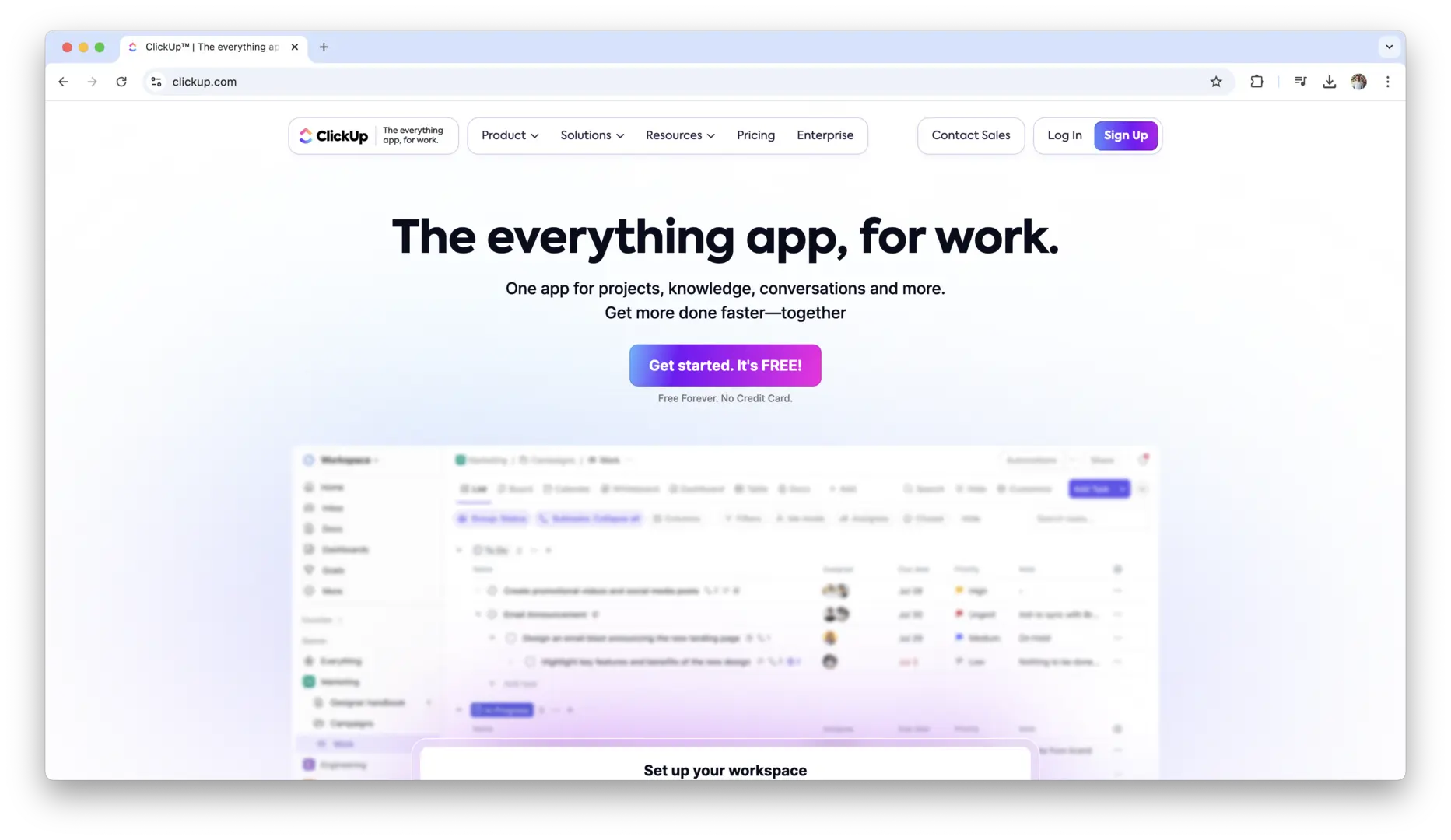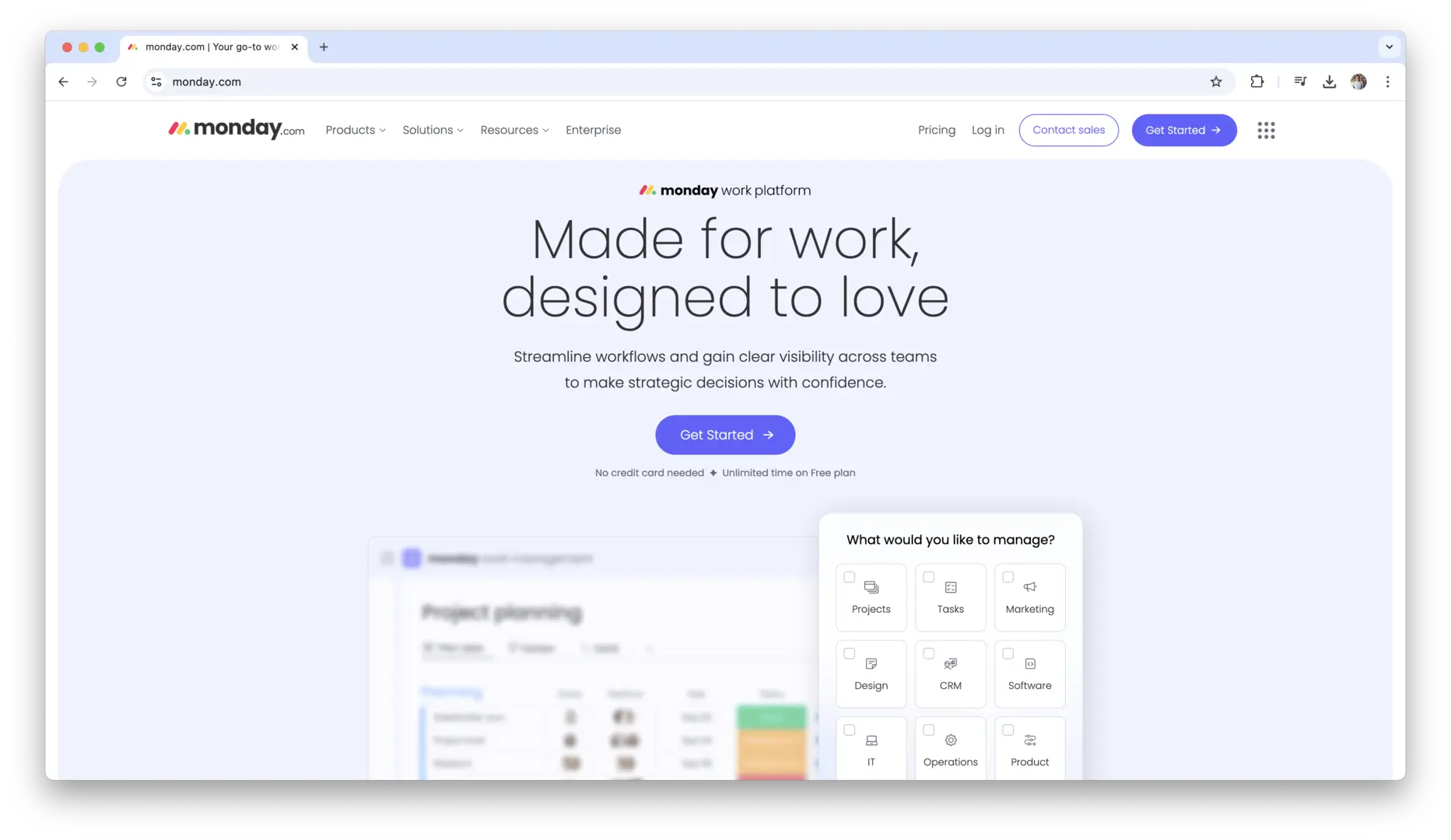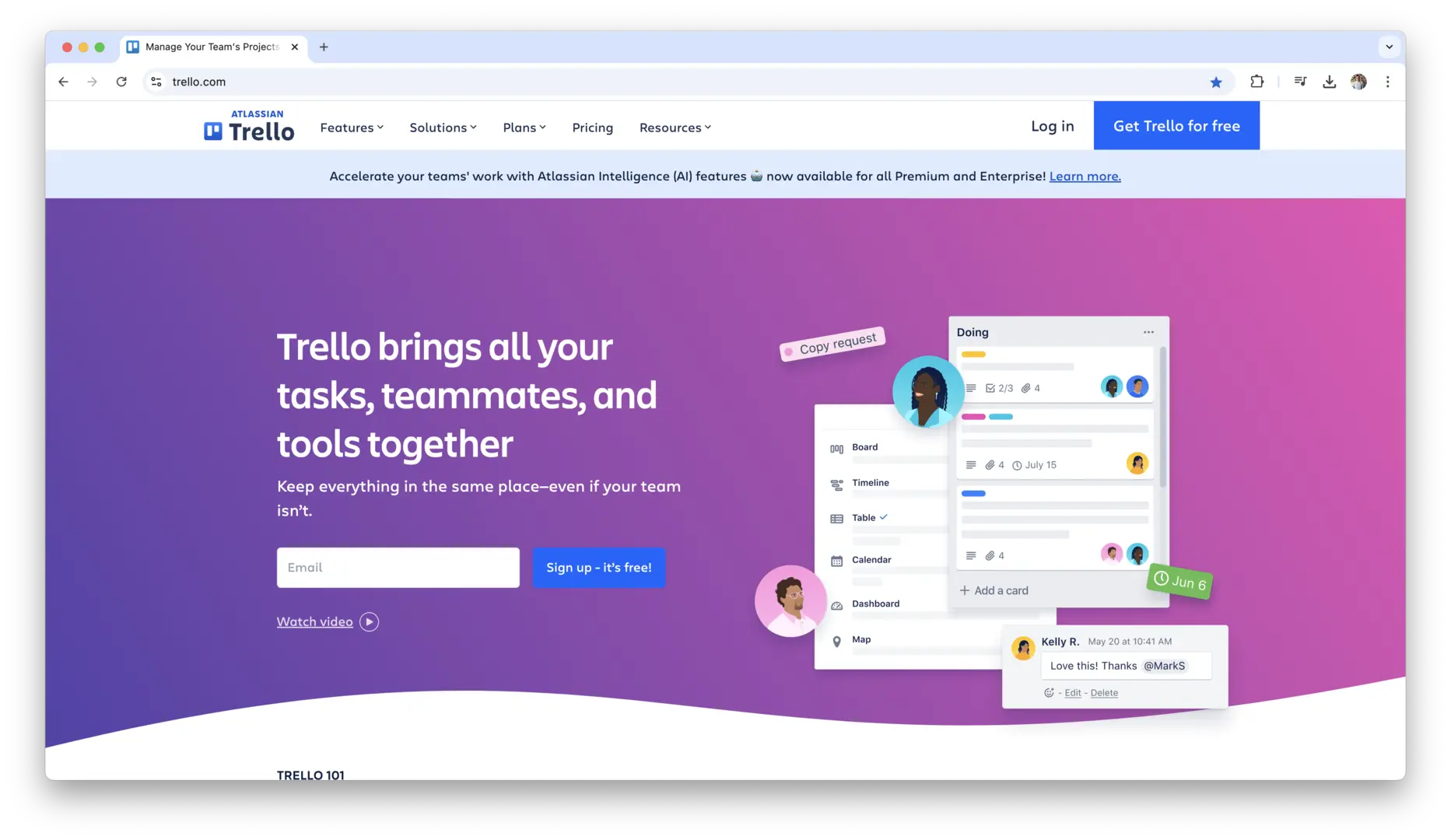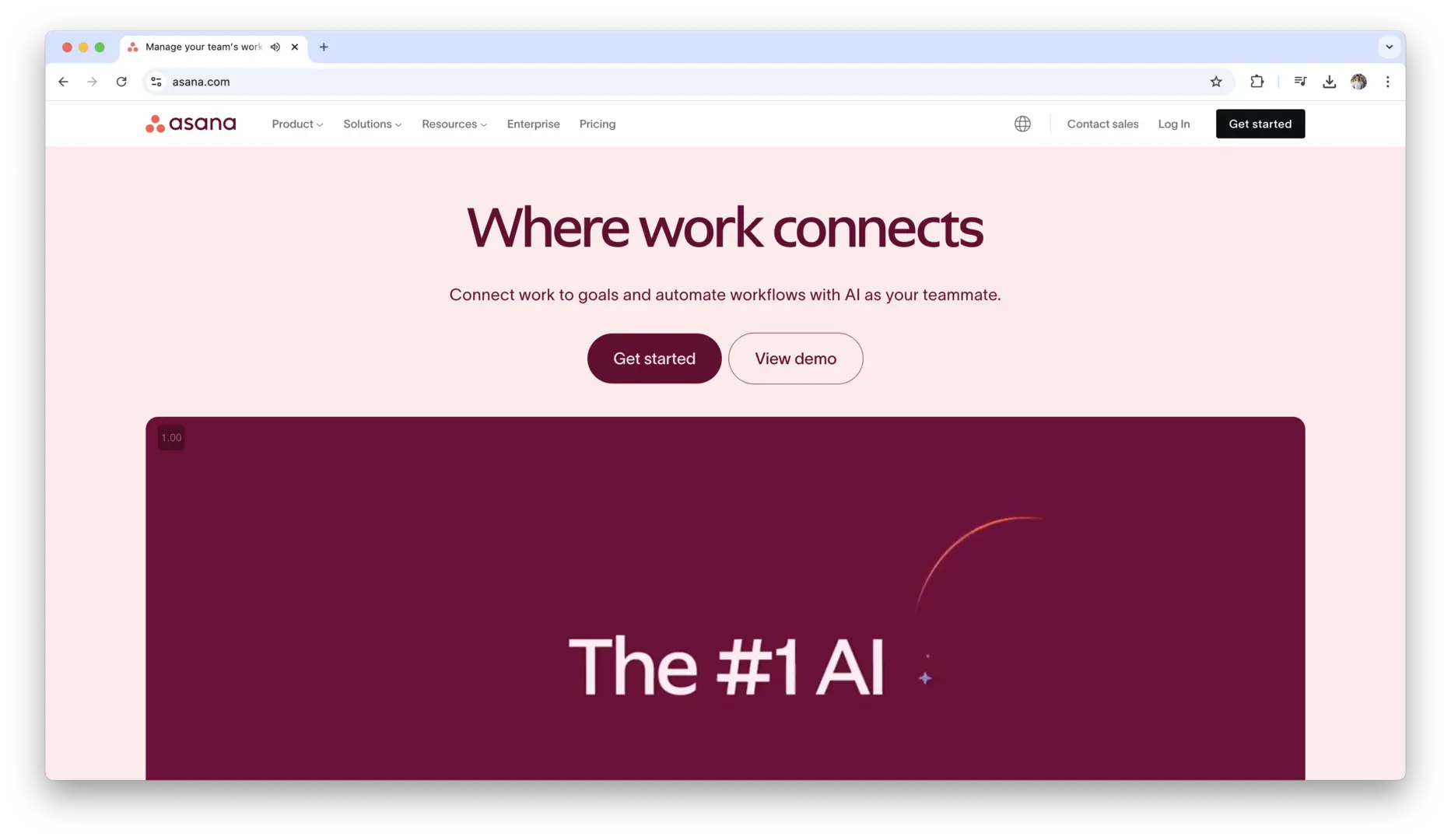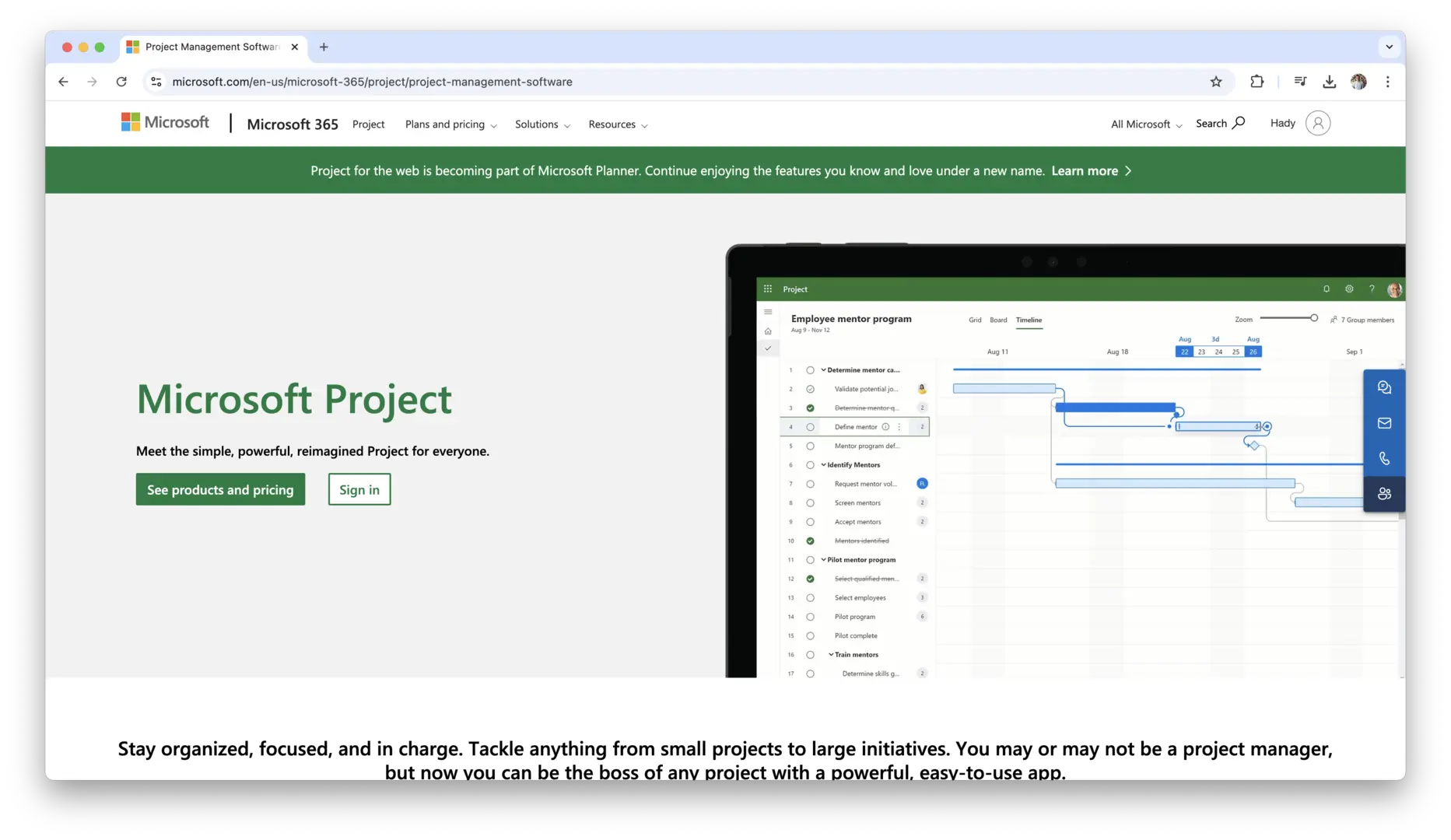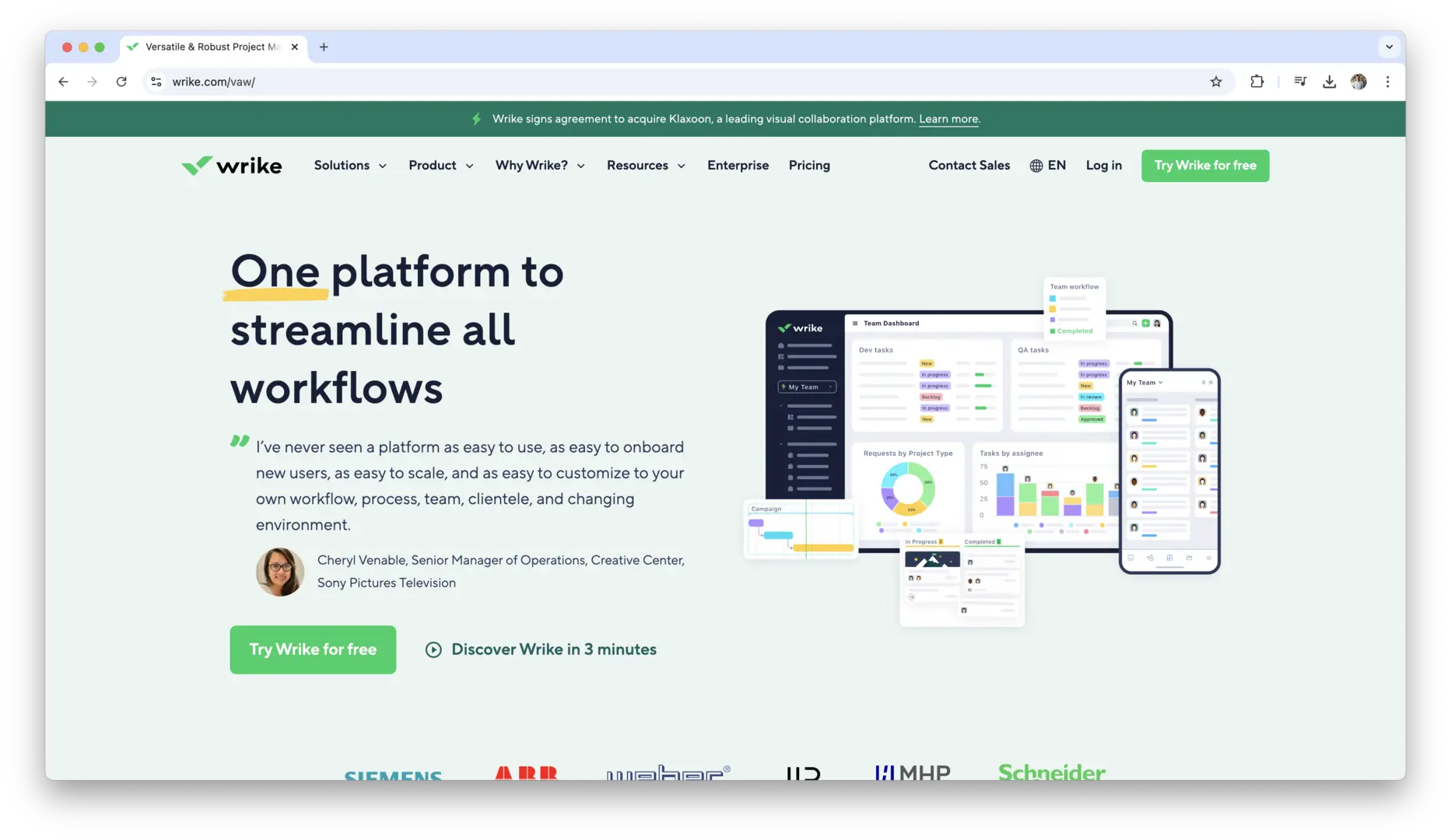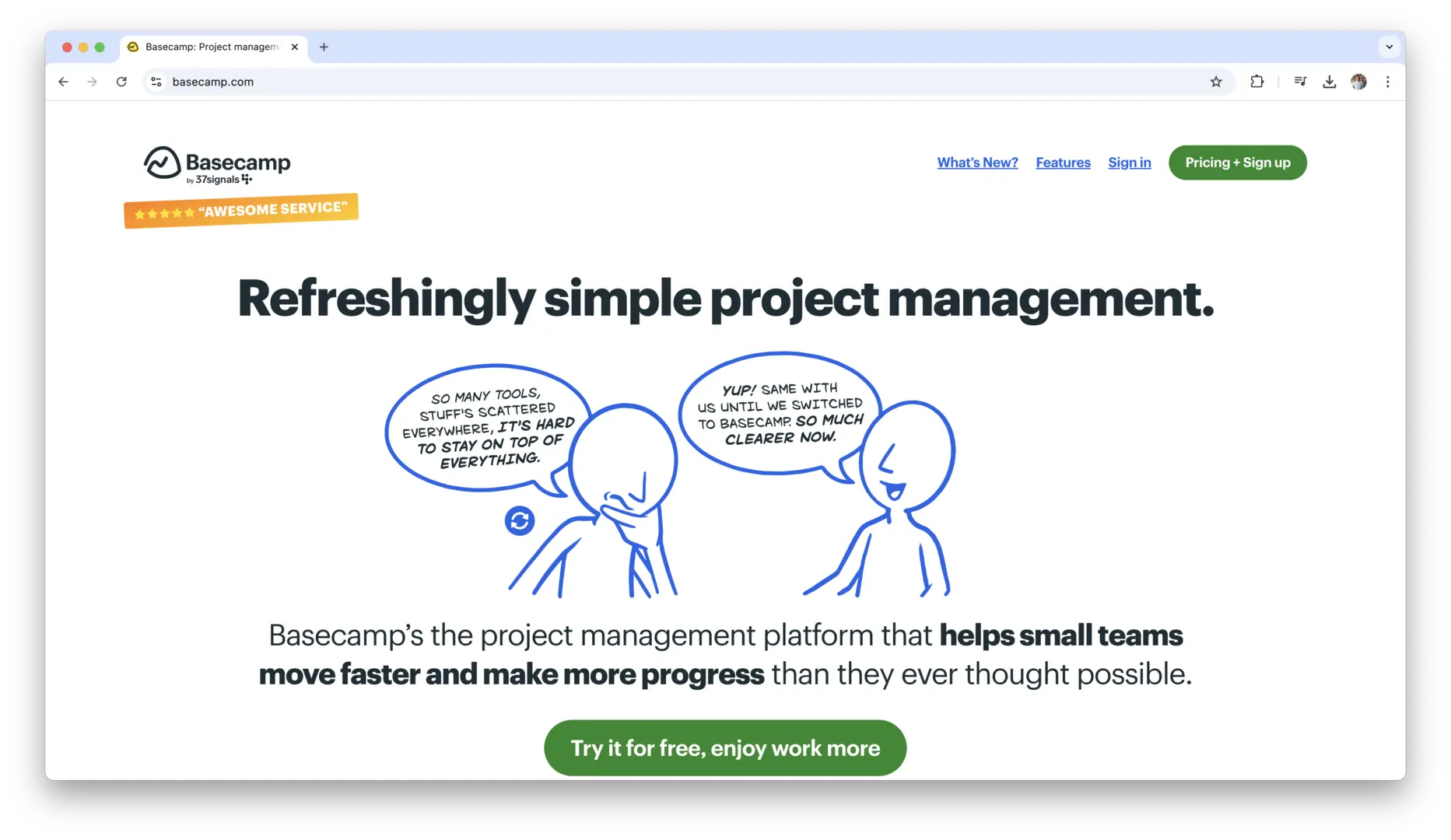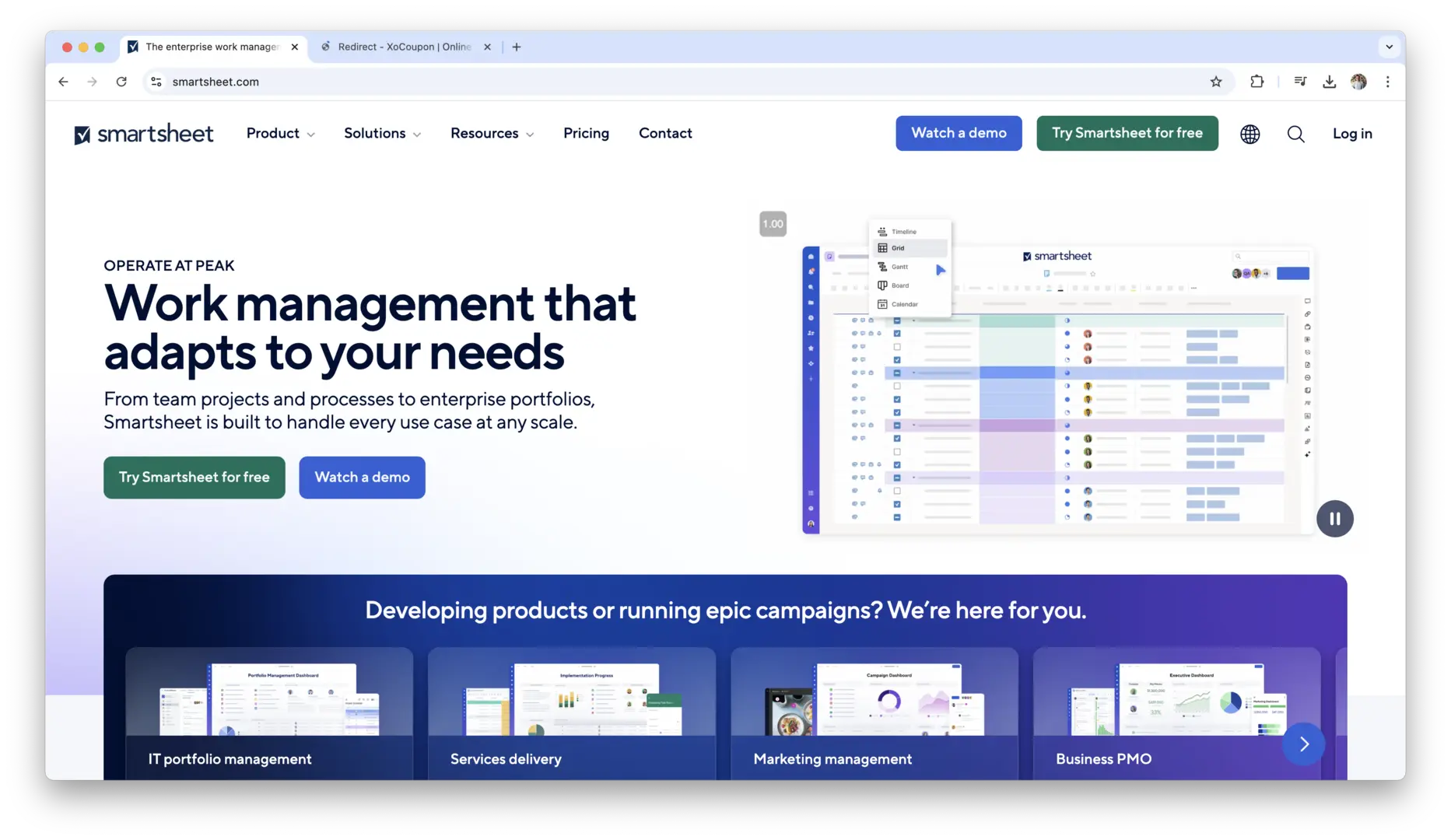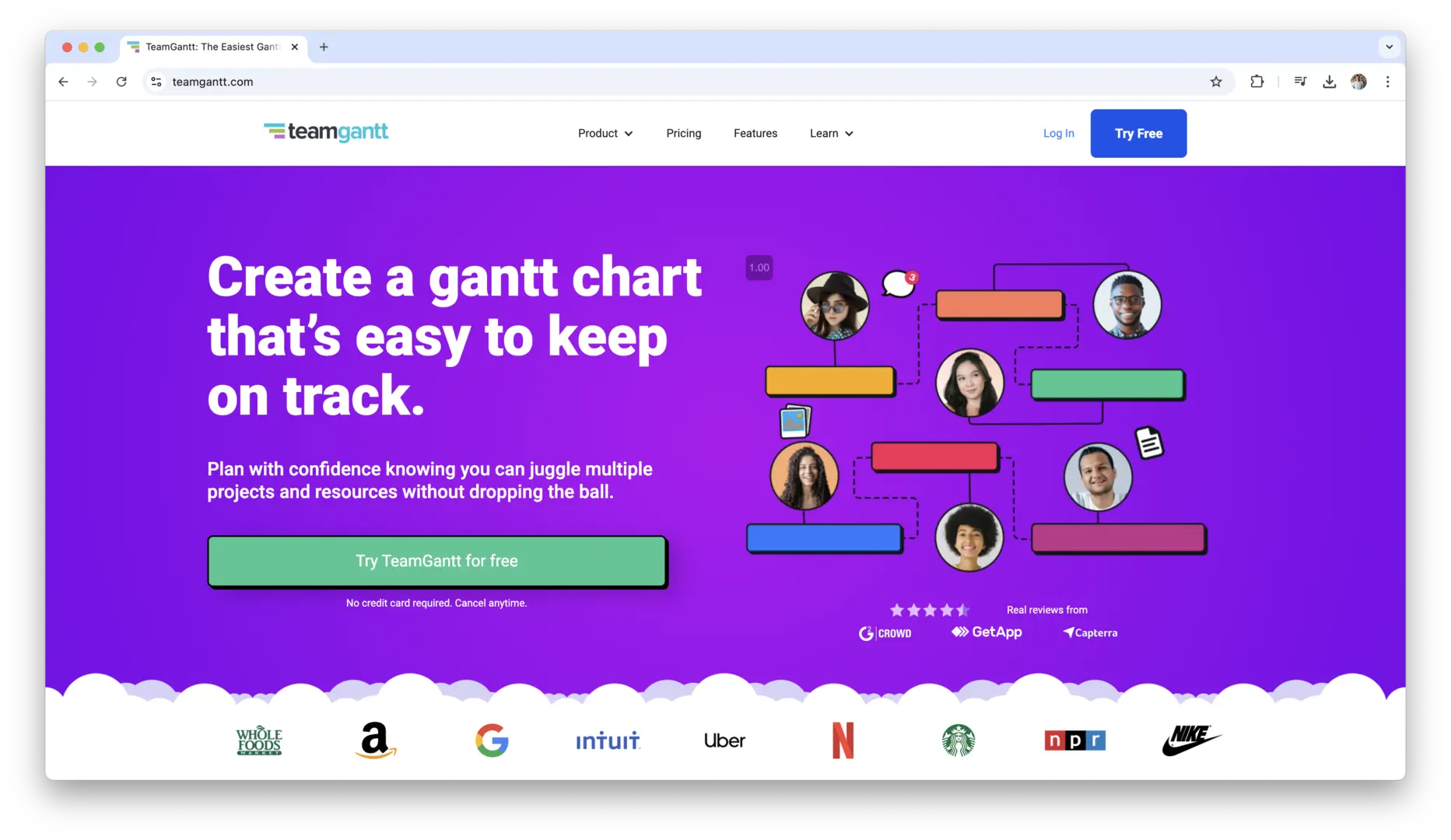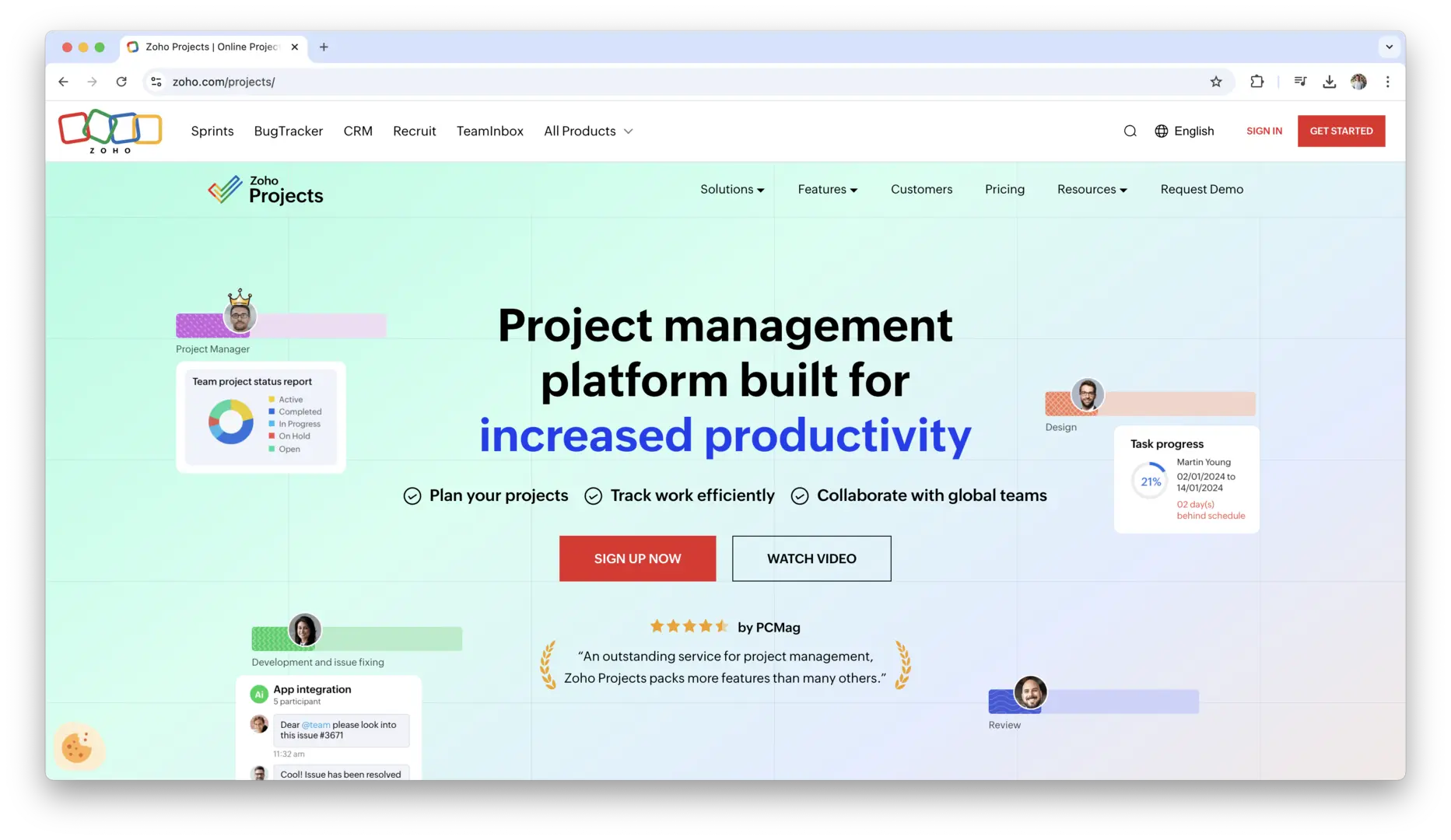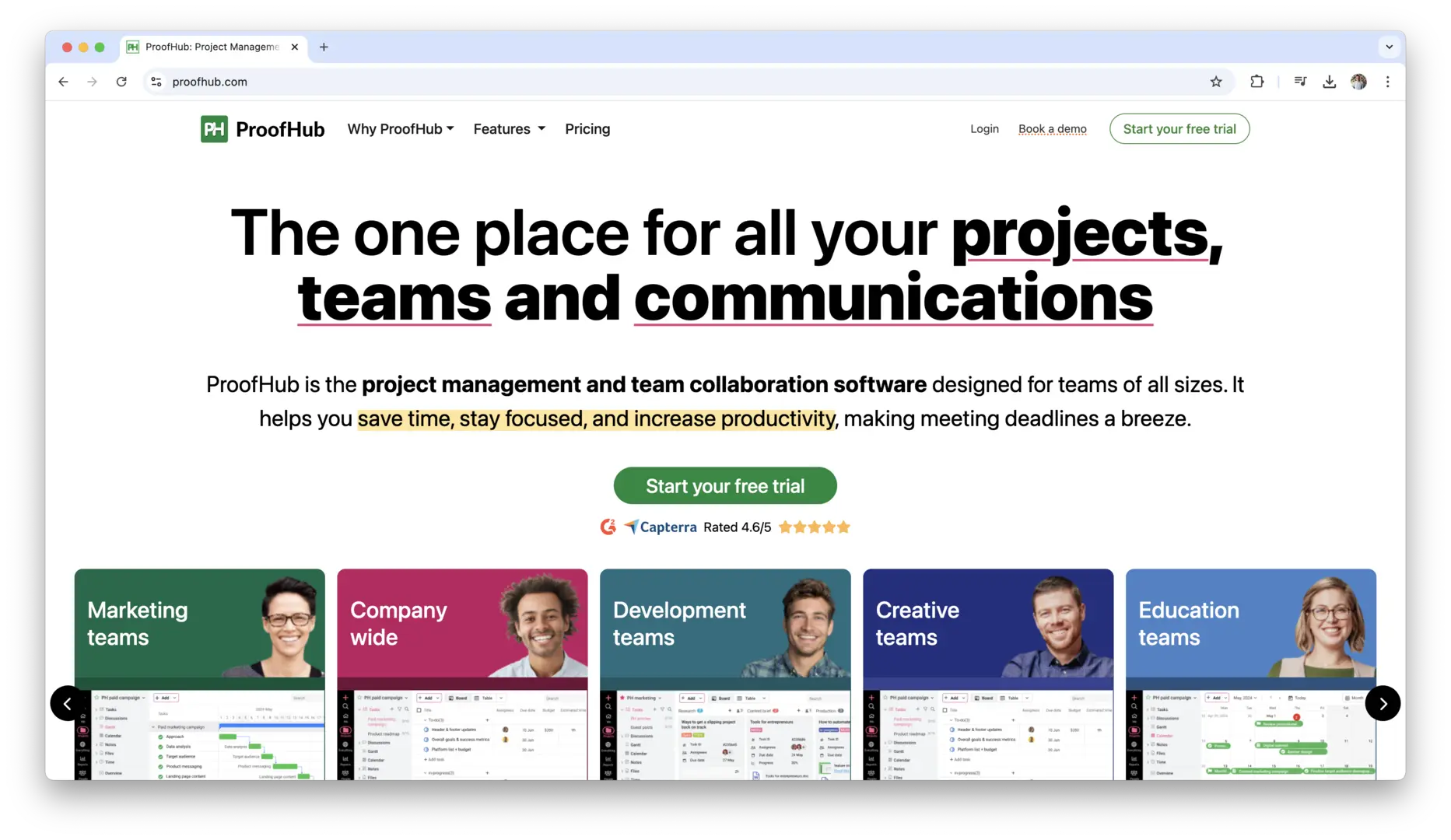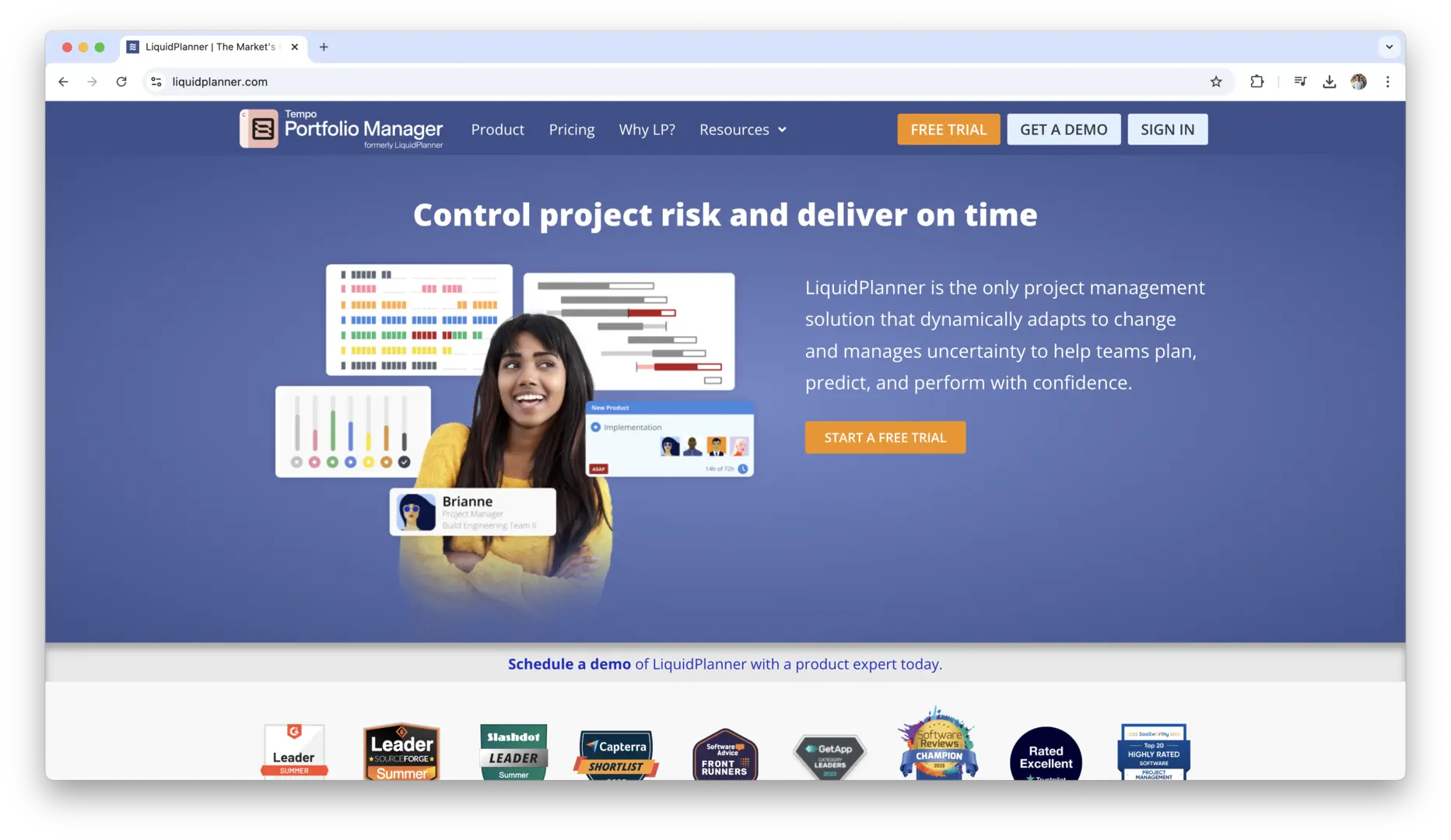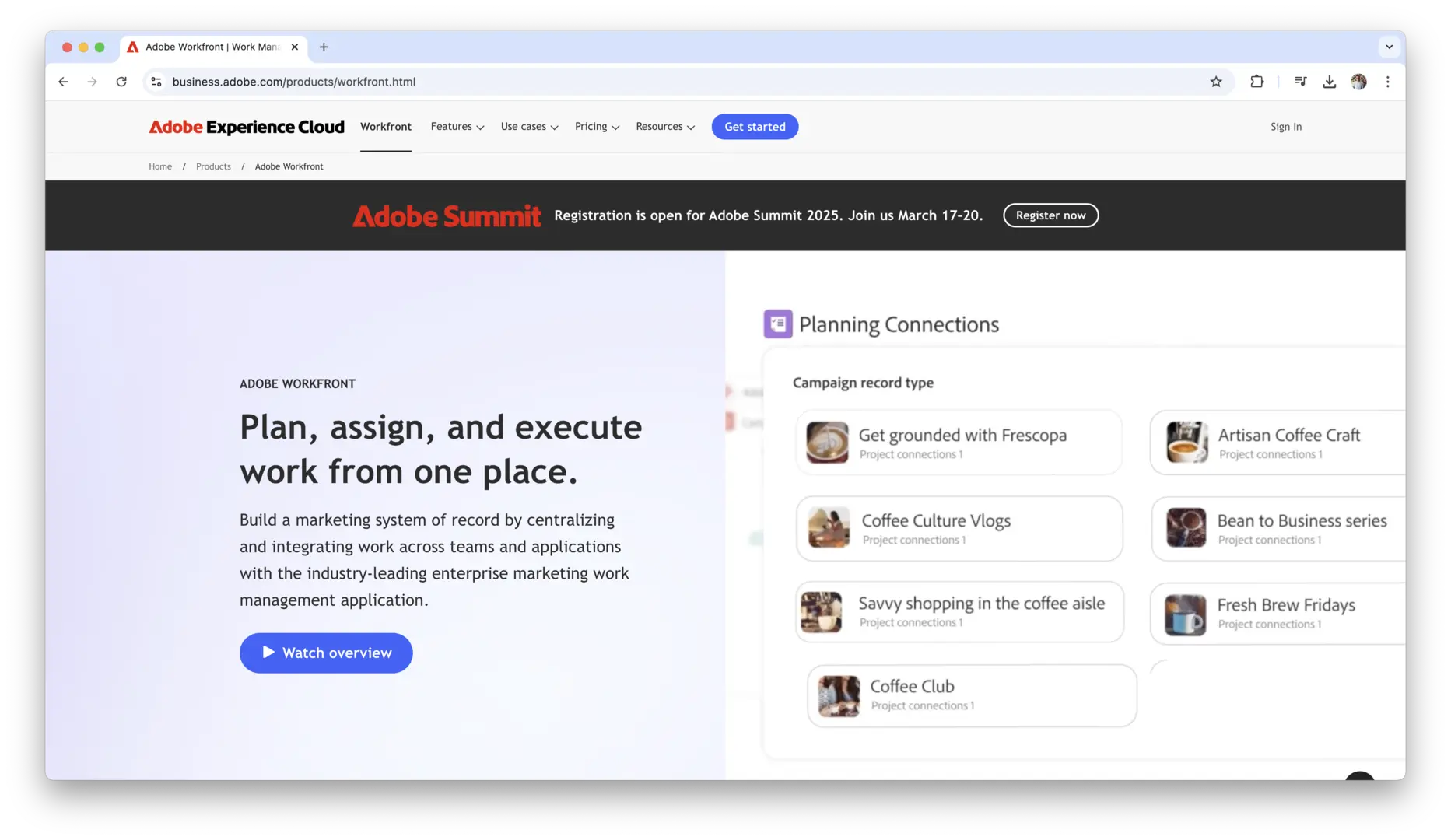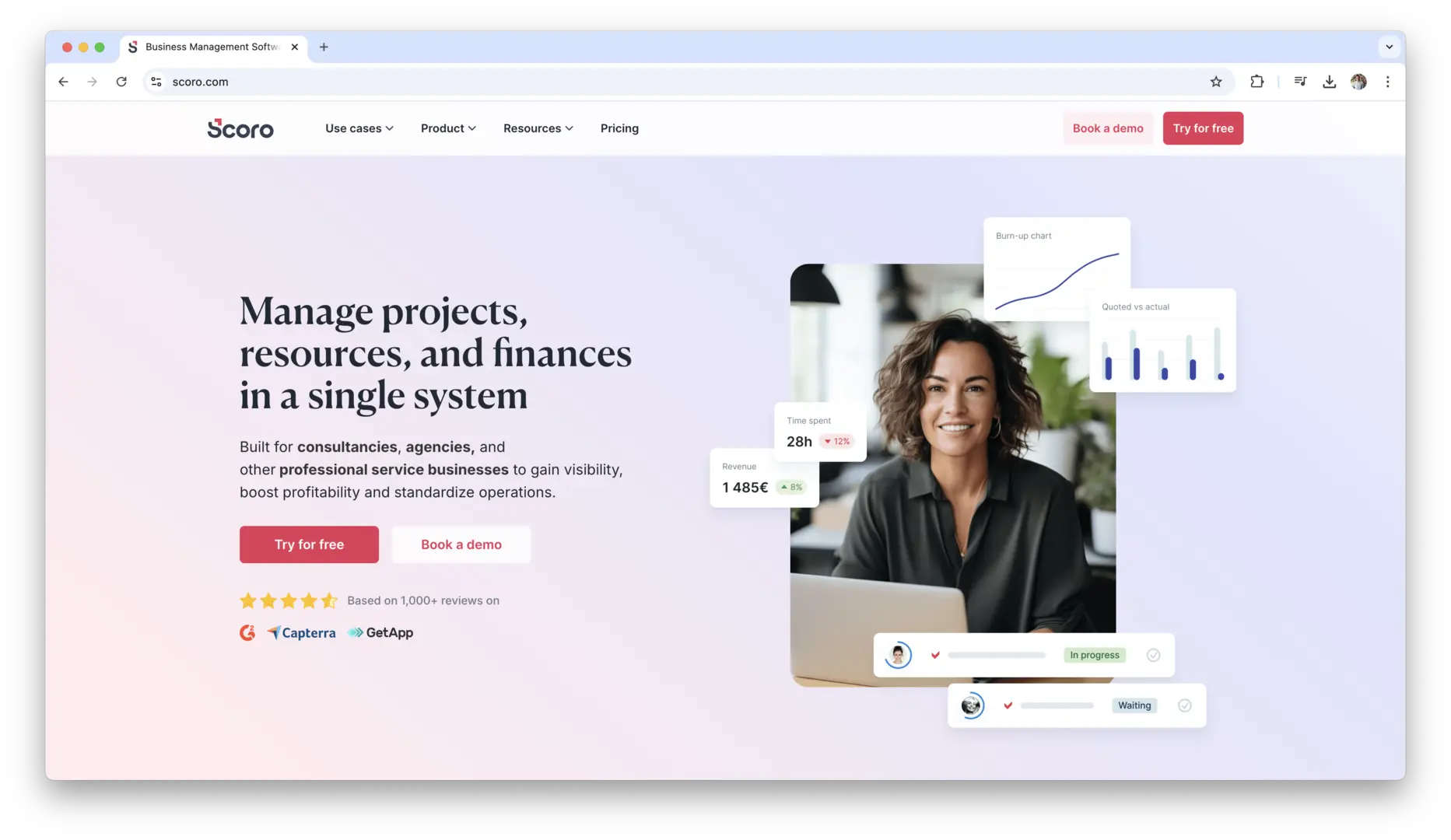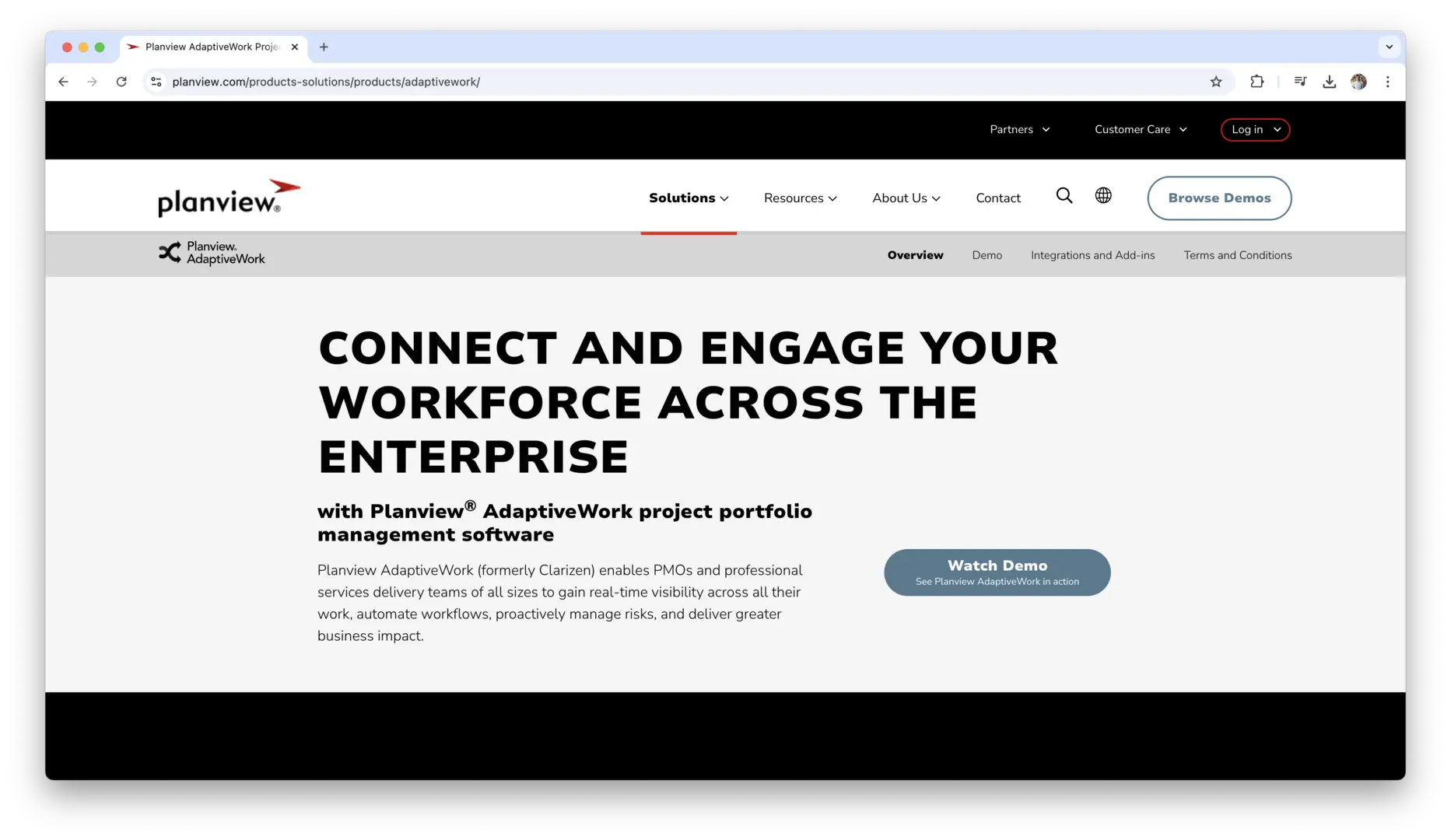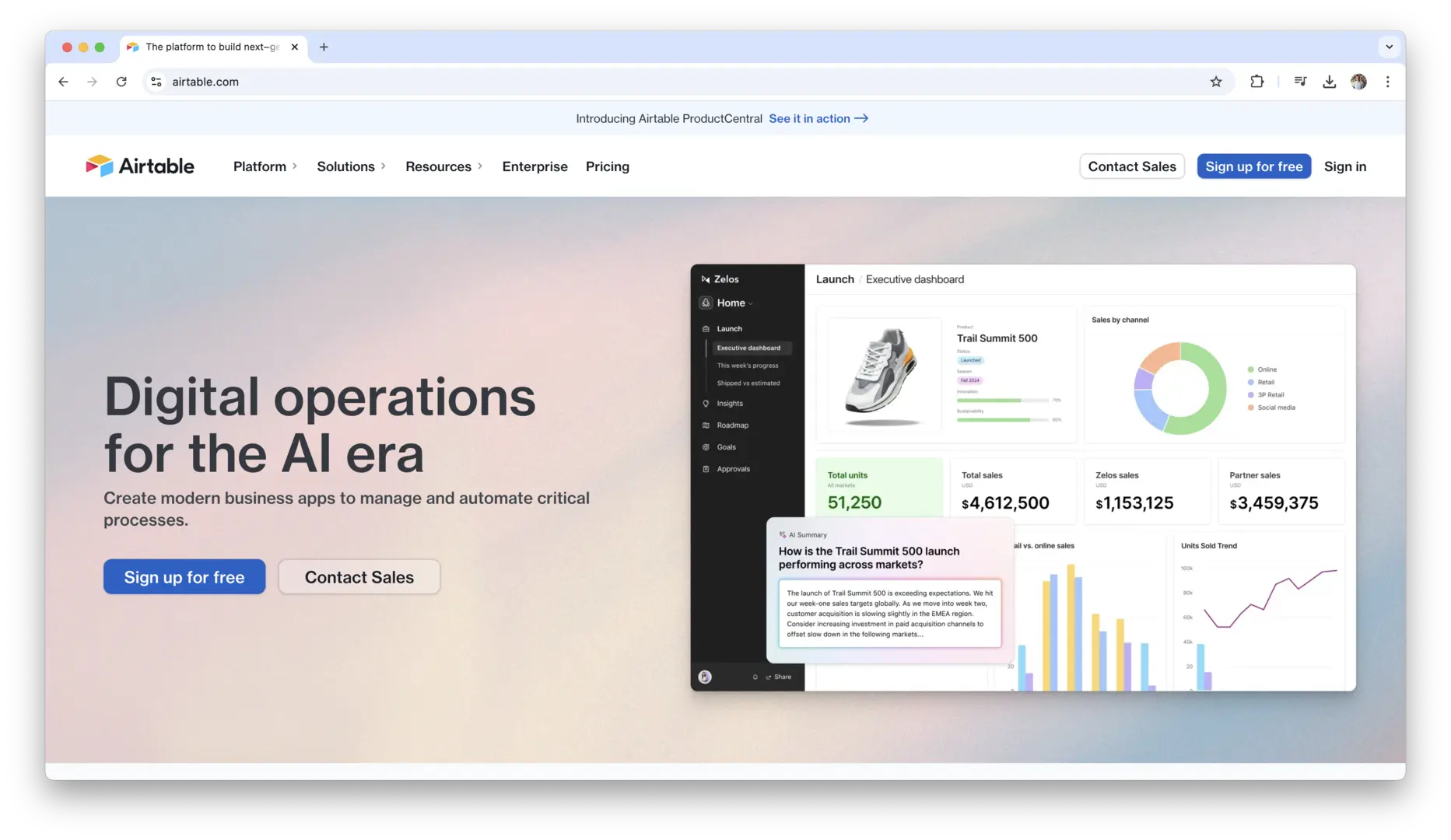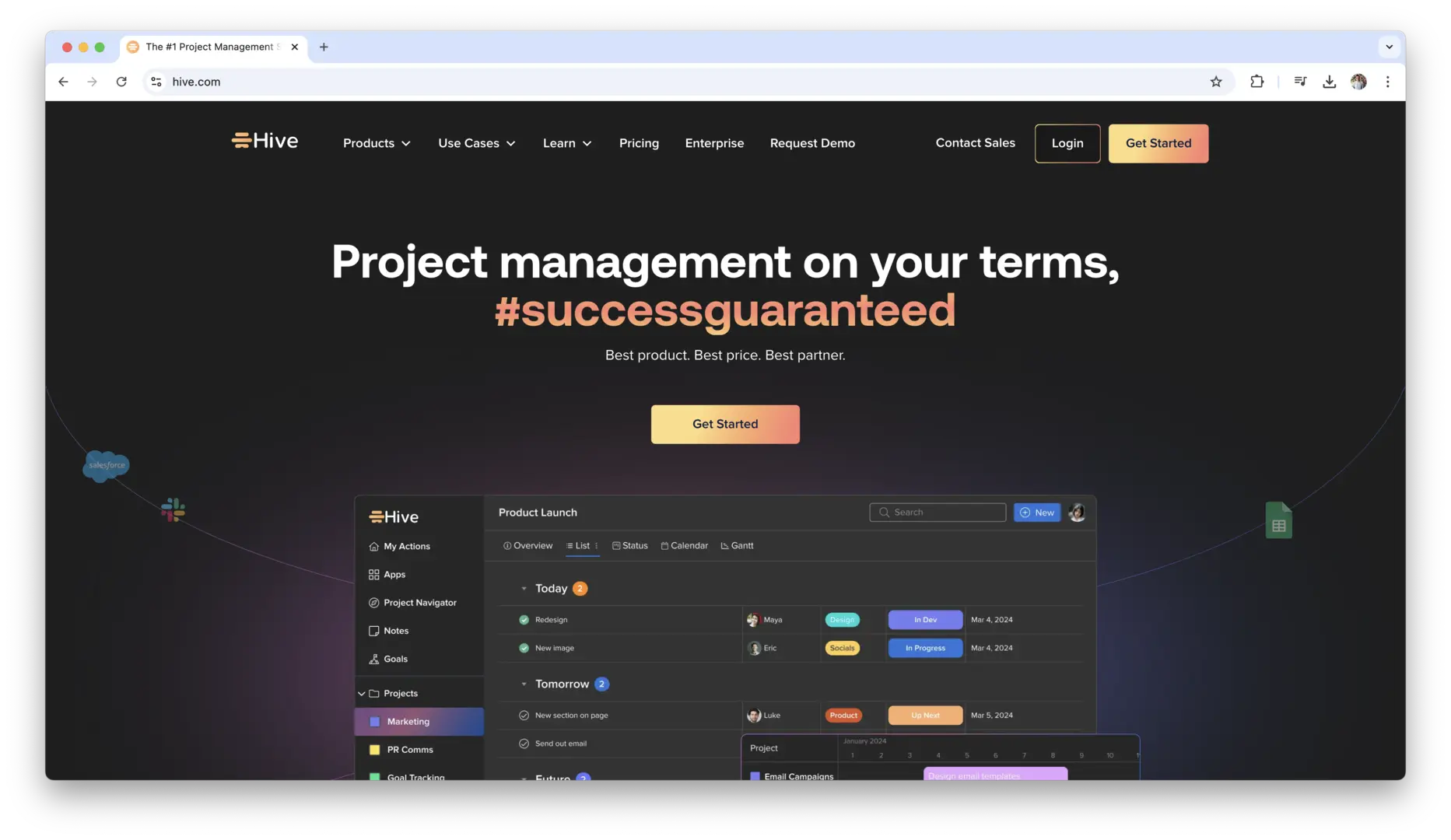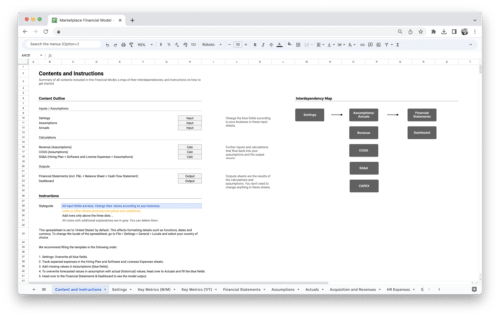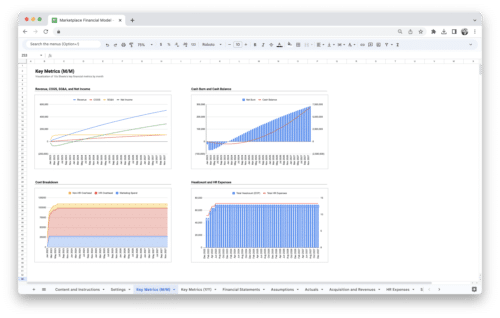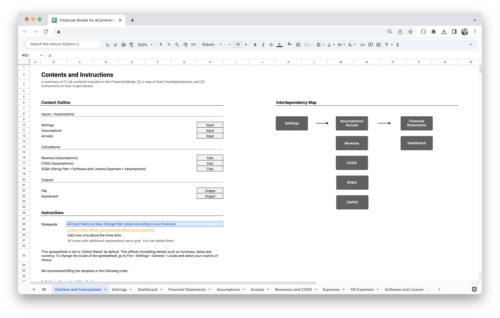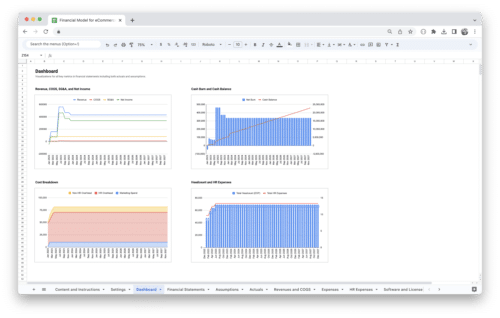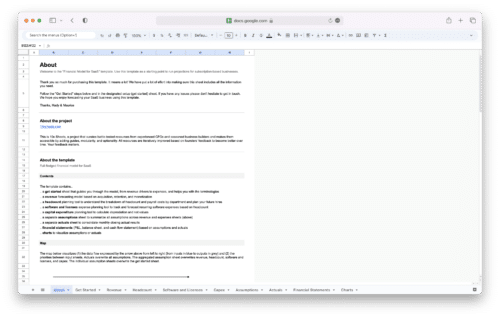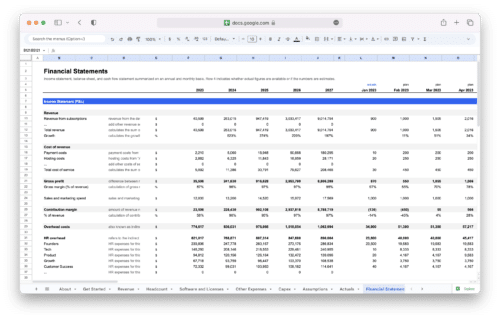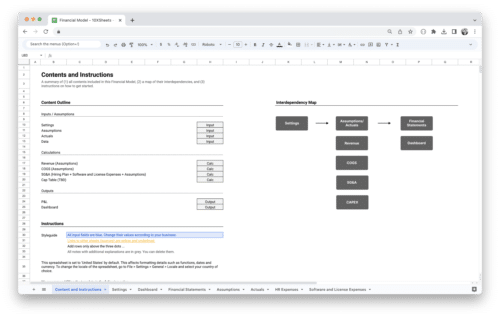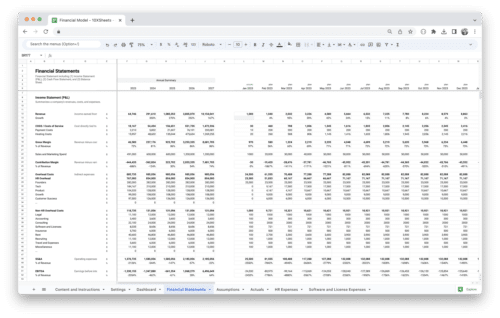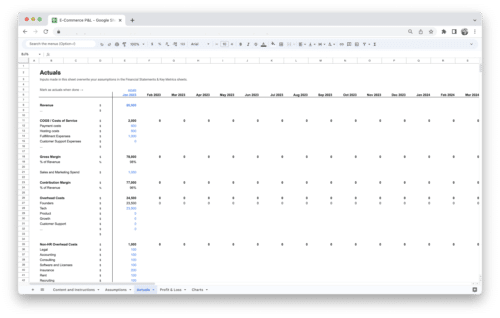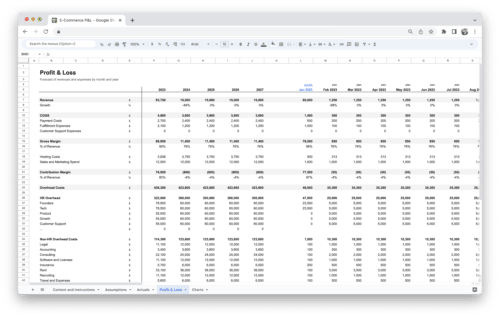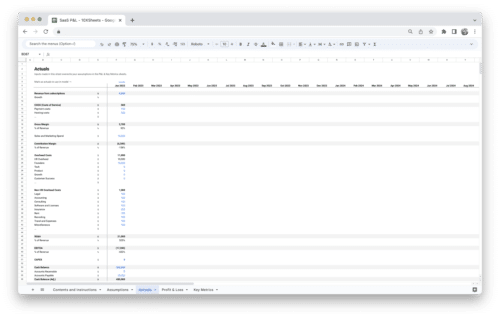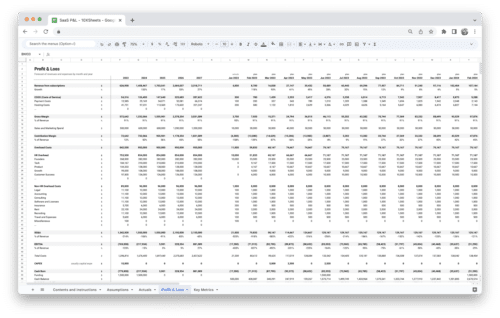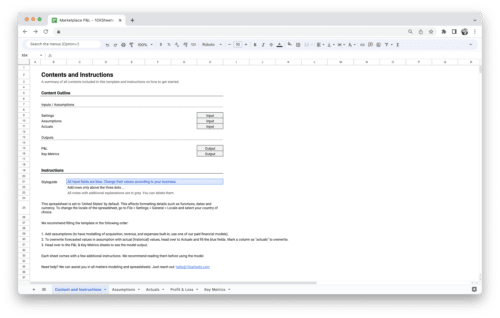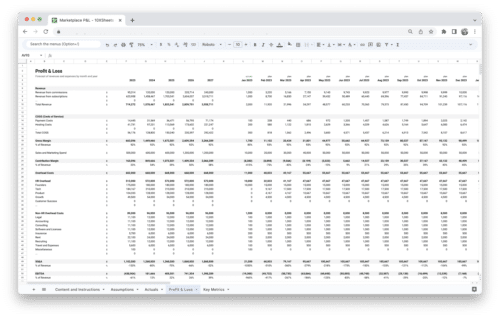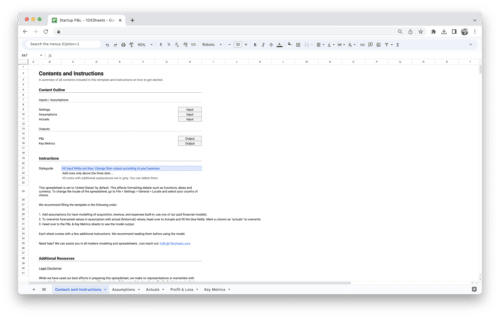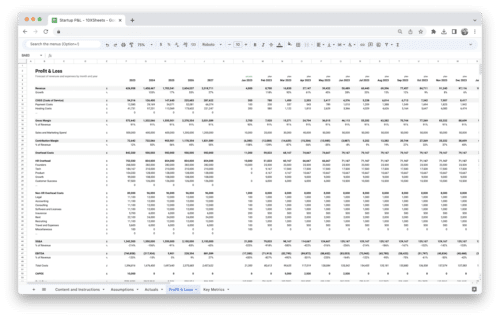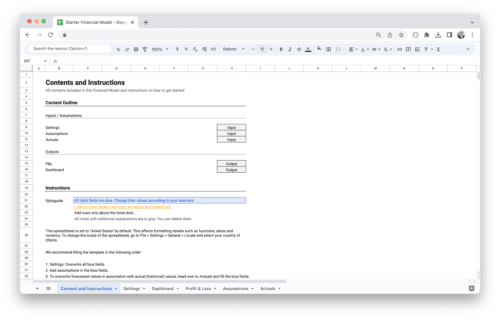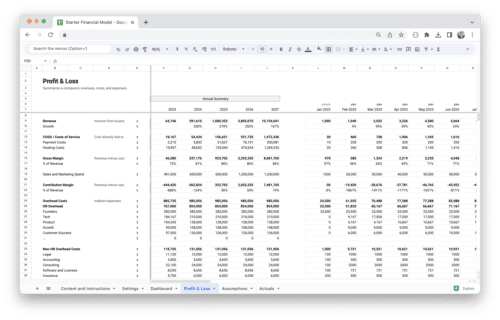Looking for the best project management software to help your team stay organized and on track? With so many options available, it can be tough to know where to start. The right project management tool can make a big difference in how efficiently your team works, helping you plan, track, and collaborate more effectively. Whether you’re managing a small team or overseeing large, complex projects, the right software can streamline tasks, improve communication, and keep everything running smoothly.
This guide highlights some of the best project management tools available today, each offering unique features designed to meet different team needs. From simple task management to more advanced features like Gantt charts and resource allocation, we’ve got you covered with the top choices that can help take your projects to the next level.
What is Project Management?
Project management is the process of planning, organizing, and overseeing the completion of a project, ensuring it is completed on time, within scope, and on budget. It involves coordinating resources, managing tasks, and leading teams to achieve specific goals. This discipline encompasses several key phases, such as initiation, planning, execution, monitoring, and closure. A successful project requires careful attention to detail, strategic thinking, and the ability to adapt to changing circumstances.
Importance of Project Management
Effective project management is critical for the success of any organization, ensuring that resources are used efficiently and goals are met within the specified constraints. It provides structure, focus, and guidance for teams, helping to manage complexity and mitigate risks.
- Ensures projects are completed on time and within budget: Proper planning and tracking help avoid delays and prevent budget overruns.
- Improves resource allocation: Helps in managing human, financial, and physical resources effectively to optimize output.
- Enhances risk management: By identifying potential issues early, project management enables teams to take proactive measures to mitigate risks.
- Aligns project goals with organizational objectives: Ensures that projects contribute directly to the broader strategic goals of the organization.
- Increases team accountability: Clear roles, tasks, and deadlines help hold team members accountable for their contributions.
- Fosters continuous improvement: Project management encourages reflection on outcomes, allowing teams to improve processes for future projects.
What is Project Management Software?
Project management software refers to a digital tool designed to assist teams in planning, organizing, and tracking the progress of projects. It streamlines various aspects of project execution, such as task assignment, scheduling, resource management, and communication. These tools are equipped with features like dashboards, Gantt charts, Kanban boards, and reporting tools that allow project managers to keep track of deadlines, monitor project performance, and collaborate with team members.
Importance of Project Management Software
Project management software plays a vital role in ensuring that projects run smoothly, providing teams with the tools they need to collaborate efficiently and track progress in real-time. These tools help streamline operations, reduce the risk of errors, and foster transparency, making it easier to manage both large and small projects.
- Increases efficiency: Automates administrative tasks, freeing up time for more critical work.
- Centralizes project information: Keeps all project-related data in one place, making it easy for team members to access and update.
- Improves team communication: Enables real-time communication and collaboration, reducing misunderstandings and delays.
- Enhances decision-making: Provides insights through data and analytics, helping teams make informed decisions.
- Boosts transparency: Ensures that everyone involved in the project has access to the same information, promoting accountability.
The Role of Tools in Streamlining Project Workflows
Project management tools play a crucial role in optimizing workflows by automating repetitive tasks, simplifying communication, and providing a centralized platform for all project-related activities. These tools allow project managers and team members to visualize project timelines, track progress, and collaborate efficiently, reducing the risk of miscommunication or missed deadlines. By organizing tasks, setting priorities, and monitoring key performance indicators, these tools help streamline processes and ensure smooth project execution.
By providing the structure and visibility needed to manage complex projects, these tools remove much of the manual effort associated with traditional project management, making it easier to focus on achieving project goals.
How the Right Software Can Improve Productivity and Team Collaboration
Choosing the right project management software can significantly enhance productivity and foster collaboration among team members. The right tool offers a range of features that facilitate task management, communication, and workflow optimization, all of which contribute to improved efficiency and better outcomes.
- Task tracking: With clear task assignments, deadlines, and priorities, team members know exactly what is expected of them, minimizing confusion and improving focus.
- Real-time updates: Collaboration is enhanced when everyone has access to the latest project information. Features like real-time editing, notifications, and progress tracking help teams stay aligned and ensure that everyone is working with the most up-to-date data.
- Centralized communication: Many project management tools offer built-in communication features such as chats, comments, and file sharing, reducing the need for emails and external communication platforms.
- Increased accountability: By assigning specific tasks and tracking progress, team members are held accountable for their responsibilities, which can lead to better performance and timely delivery.
- Remote collaboration: These tools enable teams to work together seamlessly, even if they are in different locations. Cloud-based platforms allow for easy access from any device, fostering a flexible work environment that improves overall team productivity.
Top Project Management Software Solutions
Choosing the right project management software can be overwhelming given the variety of options available. Each tool offers its own set of features and benefits designed to cater to different team sizes, project types, and business needs. Below are some of the top project management software solutions that have proven their worth in helping teams plan, track, and collaborate effectively.
ClickUp
ClickUp is an all-in-one project management solution that aims to replace multiple tools with one platform. It combines task management, document collaboration, goal tracking, and communication in a single interface. Teams can track everything from project timelines to employee workload, making ClickUp a versatile tool for managing all types of projects. The software offers a range of views, including list, board, Gantt chart, and calendar, which gives teams the flexibility to manage projects in the way that suits them best.
ClickUp’s wide range of integrations, customizability, and automation features make it an attractive option for businesses that need a comprehensive tool to manage projects of any size. Its intuitive design ensures that teams can quickly adapt to the platform, but its extensive features also mean that it can support more complex workflows and tasks as needed.
Monday.com
Monday.com is an intuitive, visual project management platform designed to help teams collaborate and track progress. It offers customizable workflows, which allow teams to build their project boards to fit their specific needs. Monday.com supports various views, such as Kanban, Gantt charts, and calendar views, which makes it easy to switch between project management styles. The tool is highly adaptable and can be used across industries, from marketing to IT and construction.
Its automation features help to eliminate repetitive tasks, ensuring that team members focus on the most important aspects of their work. Monday.com also offers robust reporting capabilities, customizable dashboards, and integrations with a wide range of tools, including Zoom, Microsoft Teams, and more. It’s particularly well-suited for teams looking for flexibility and customization.
Trello
Trello is a popular project management tool known for its simplicity and visual interface. It uses a Kanban-style board that allows teams to organize tasks into columns such as “To Do,” “In Progress,” and “Completed.” Trello’s drag-and-drop interface makes it easy to add, move, and track tasks, making it a great choice for smaller teams or those new to project management software. While it’s feature-rich for basic project management, Trello also offers integrations with a variety of third-party tools like Slack, Google Drive, and more, allowing teams to extend its capabilities as needed.
Trello’s simplicity makes it easy to get started with, but it’s also flexible enough to accommodate various workflows. However, for more complex project management needs, it may require power-ups or integrations with other tools.
Asana
Asana is known for its powerful task management capabilities and is suitable for teams of all sizes. With features like task dependencies, timeline views, and project milestones, Asana makes it easy to track and organize tasks. The platform allows teams to set deadlines, assign tasks, and even create detailed project workflows that can be adjusted as needed. Asana also provides reporting features to track project progress, helping teams to make data-driven decisions.
The tool’s user-friendly interface, combined with its strong task-tracking and collaboration features, makes it ideal for teams looking for a balance between simplicity and advanced functionality. Asana integrates with numerous tools, including Slack, Dropbox, and Google Workspace, which can enhance its capabilities and streamline workflows.
Microsoft Project
Microsoft Project is one of the most well-established project management tools and is known for its powerful scheduling, resource management, and reporting capabilities. It’s suitable for large teams and more complex projects that require detailed planning and monitoring. Microsoft Project allows teams to create Gantt charts, track project timelines, and manage resources effectively, making it a go-to solution for project managers in industries such as construction, engineering, and IT.
While the software has a steep learning curve, its depth of features, such as resource leveling, portfolio management, and cost tracking, makes it a valuable tool for those who need advanced project management functionality. It integrates seamlessly with other Microsoft products, including Excel, SharePoint, and Teams, making it an ideal choice for businesses already within the Microsoft ecosystem.
Wrike
Wrike is a robust project management platform that offers advanced features suited for teams that need comprehensive project planning, tracking, and reporting. It provides tools for task management, collaboration, and time tracking, along with detailed reporting features for tracking project health. Wrike’s flexibility allows teams to use customizable templates and workflows to meet specific project needs, making it ideal for businesses with more complex or diverse projects.
Wrike’s real-time collaboration tools, such as document sharing and communication features, ensure that teams can stay in sync. It also offers integrations with other tools, including Salesforce, Slack, and Google Drive, making it a great choice for teams looking to connect their workflows across multiple platforms. With strong reporting and analytics capabilities, Wrike is particularly useful for teams that require in-depth project insights.
Basecamp
Basecamp is a popular project management tool that focuses on simplicity and collaboration. It combines to-do lists, message boards, file storage, and calendars in one platform, making it easy for teams to stay organized. Basecamp’s interface is straightforward, ensuring that even teams with little experience with project management tools can use it effectively. It offers essential features such as task assignments, project milestones, and automatic check-ins.
Basecamp is well-suited for smaller teams or businesses looking for an uncomplicated solution to project management. Its focus on collaboration and communication makes it a solid choice for teams that need to stay connected and organized without the complexity of larger project management systems. However, it may lack some of the advanced features available in other tools, such as detailed reporting or complex workflow management.
Smartsheet
Smartsheet combines the familiarity of a spreadsheet with powerful project management features. Its grid interface makes it easy to manage tasks, track progress, and share information across teams. Smartsheet supports Gantt charts, calendars, and task lists, providing flexibility in how projects are visualized and managed. Teams can use it for task tracking, resource allocation, and budgeting, all while maintaining a high level of customization.
The tool is particularly beneficial for teams that are already accustomed to using spreadsheets for tracking tasks and projects. Smartsheet’s powerful automation features, reporting capabilities, and integrations with other platforms like Microsoft Teams and Salesforce make it a versatile option for teams that need a robust, yet user-friendly, project management solution.
TeamGantt
TeamGantt is a user-friendly project management tool focused on Gantt chart-based project planning. It allows teams to easily plan, schedule, and collaborate on projects through interactive timelines. TeamGantt is particularly suited for teams that prefer visual tools to track project progress. It offers drag-and-drop functionality, resource management, and task dependencies, making it easy to adjust schedules in real time.
With its straightforward approach to Gantt charts, TeamGantt is an excellent choice for teams looking to visualize their projects and manage timelines with minimal complexity. It also integrates with tools like Slack and Google Drive, enhancing team collaboration.
Zoho Projects
Zoho Projects is an online project management software that combines task management, collaboration, and time tracking. It offers a range of features, including Gantt charts, milestone tracking, and document management. The platform’s task automation capabilities streamline project workflows, allowing for easier task assignment and progress tracking.
Zoho Projects also integrates seamlessly with other Zoho tools, such as Zoho CRM and Zoho Analytics, making it a great option for teams already using the Zoho suite. Its scalability and customization options make it suitable for teams of all sizes, from small startups to larger enterprises.
ProofHub
ProofHub is a project management tool designed for teams that need a simple yet effective way to plan, track, and collaborate. It includes features such as task management, time tracking, document sharing, and communication tools. ProofHub’s unique selling point is its simplicity, offering a clean interface that focuses on delivering essential project management functions without overwhelming users.
Teams looking for a straightforward, no-frills tool will benefit from ProofHub’s combination of features, particularly its real-time collaboration and proofing tools for marketing or creative teams.
LiquidPlanner
LiquidPlanner is a robust project management software known for its predictive scheduling and resource management features. The software uses dynamic scheduling to adjust project timelines based on team capacity and task priority. LiquidPlanner’s approach to project management is based on uncertainty, allowing teams to plan and prioritize work while accounting for changing conditions.
This makes LiquidPlanner particularly useful for teams working in fast-paced or highly dynamic environments, where tasks and deadlines may frequently shift. It also includes strong reporting tools to monitor project health and resource utilization.
Adobe Workfront
Adobe Workfront is an enterprise-level project management solution that focuses on team collaboration, project execution, and task management. Its customizable workflows, resource management tools, and real-time reporting features make it an ideal choice for large organizations that need to manage multiple complex projects simultaneously.
Workfront offers integrations with other enterprise software solutions like Adobe Creative Cloud, Microsoft Teams, and Salesforce, enabling teams to centralize all project activities in one platform. Its advanced reporting and analytics also provide valuable insights into project progress and performance.
Scoro
Scoro is an all-in-one business management software that integrates project management, time tracking, CRM, billing, and reporting in a single platform. It allows teams to manage tasks, schedules, and resources efficiently, with the added benefit of tracking finances and client relationships in one place. Scoro’s project management features include task dependencies, Gantt charts, and collaborative tools to streamline communication.
With its emphasis on business management and project management, Scoro is an excellent choice for teams looking for a comprehensive solution that combines project execution with business tracking.
Planview AdaptiveWork
Planview AdaptiveWork project portfolio management software (formerly Clarizen) is an enterprise-grade project management tool designed to help teams collaborate, manage workflows, and optimize resources. It includes customizable workflows, Gantt charts, and a wide range of reporting and analytics tools. AdaptiveWork’s automation features help streamline repetitive tasks, reducing manual effort and improving efficiency.
Ideal for larger organizations, Planview AdaptiveWork also offers strong project tracking and resource management capabilities, making it a suitable choice for complex projects and multi-department teams. It integrates with popular tools like Salesforce and Microsoft Teams, helping to centralize all project activities in one platform.
Airtable
Airtable is a versatile project management tool that combines the functionality of spreadsheets with project management features. Teams can track tasks, create customizable workflows, and visualize data in a variety of views such as grid, calendar, and Kanban. Airtable’s flexible nature makes it suitable for teams that need a tool that can adapt to different workflows and project types.
Airtable stands out for its ease of use and customization options. It’s perfect for teams that need a simple, intuitive way to manage projects while retaining the flexibility to adapt the tool to specific needs.
Hive
Hive is a collaborative project management tool that offers task management, time tracking, and collaboration features. With its customizable workflows and real-time collaboration tools, Hive makes it easy for teams to plan, execute, and track progress. Hive’s key features include workload management, resource allocation, and project forecasting, helping teams optimize their resources for maximum efficiency.
Hive’s intuitive interface and integrations with Slack, Google Workspace, and other popular tools make it an excellent choice for teams looking for an all-in-one solution for managing tasks, communication, and resources. The tool is particularly beneficial for teams that work in a highly collaborative, dynamic environment.
Project Management Software Features to Look for
When selecting project management software, it’s essential to consider the specific features that will make managing projects, tasks, and teams easier and more efficient. The right software can be a game-changer, ensuring everything stays on track and aligned with your team’s goals. Here are some of the key features to prioritize when evaluating project management tools:
Task and Time Management Capabilities
Effective task management is at the heart of any successful project. A good project management tool should allow you to create, assign, and track tasks with ease. Features like task dependencies, due dates, and reminders are crucial for ensuring deadlines are met. Time tracking is also important, especially for teams that bill clients by the hour or need to track resource allocation. The ability to set time estimates and compare them against actual time spent can offer valuable insights into team performance and help with future planning.
Team Collaboration and Communication Tools
Collaboration is one of the primary reasons for using project management software. A tool with built-in messaging systems, file sharing, and comment threads allows team members to communicate without needing to switch between multiple apps. Being able to collaborate directly within tasks or projects keeps everyone on the same page and reduces the chances of miscommunication. Additionally, some tools offer integrations with other communication platforms, like Slack or Microsoft Teams, making it easier to keep discussions and notifications centralized.
Reporting and Analytics
A great project management tool should offer robust reporting features that provide valuable insights into the project’s progress, team performance, and resource utilization. Customizable dashboards, real-time reports, and performance tracking allow project managers to stay informed and make data-driven decisions. Metrics such as time-to-completion, task completion rates, and budget adherence can help pinpoint areas for improvement and ensure the project is on track. Additionally, analytics can help forecast potential issues and suggest ways to mitigate risks.
Integration with Other Tools and Platforms
Most businesses rely on multiple software tools to manage various aspects of their operations, from customer relationship management (CRM) to accounting. Therefore, seamless integration with other tools and platforms is essential. Look for project management software that integrates well with your existing systems, whether it’s for file storage, team communication, or calendar scheduling. Popular integrations include Google Workspace, Dropbox, Jira, Trello, and more. This ensures that data flows smoothly between tools, saving time and reducing the risk of errors.
Security and Data Privacy Considerations
Security is a top priority when handling sensitive project data. Whether it’s client information, proprietary business strategies, or employee details, the software should be compliant with privacy regulations like GDPR, HIPAA, or CCPA. Look for tools that offer strong encryption, secure logins (e.g., two-factor authentication), and regular security audits. Additionally, ensure the software provides clear data storage and retention policies to protect against breaches or accidental data loss.
User Interface and Experience
The user interface (UI) and overall user experience (UX) play a significant role in how effectively a team can use project management software. A clean, intuitive interface reduces the learning curve and increases adoption rates within your team. Key elements like drag-and-drop functionality, customizable views, and mobile accessibility can make managing projects on the go easier. A good UX ensures that team members can quickly access the information they need and can perform tasks efficiently without unnecessary friction or confusion. The more user-friendly the software, the more likely your team will engage with it consistently.
How to Choose the Best Project Management Tool for Your Team?
Selecting the right project management software requires careful thought, as different tools cater to varying team sizes, project types, and workflows. It’s important to match the software with your team’s needs, the complexity of the projects, and how your team works best. Here are some key factors to consider when choosing the right tool.
1. Assess the Size and Nature of Your Team
The size of your team can greatly influence the type of project management software you choose. For smaller teams, a simple, streamlined tool may suffice, offering basic task tracking and communication features. Larger teams, on the other hand, may require more advanced functionalities such as resource management, reporting tools, and integrations with other business systems.
Additionally, consider the nature of your team’s work. If your team is highly collaborative and operates in a dynamic environment, a tool that focuses on collaboration and real-time updates may be most effective. Conversely, for more structured, formal teams, a tool with detailed planning and reporting features might be a better fit.
2. Identify Project Types (Agile, Waterfall, Hybrid)
Understanding the type of projects your team handles can help you select a tool that aligns with your project management methodology.
- Agile: If your team uses Agile methods, look for tools that support iterative planning, sprints, and flexibility. Agile project management tools often include features like backlog management, sprint tracking, and Kanban boards.
- Waterfall: If your team follows a Waterfall approach, you’ll need a tool that emphasizes task dependencies, detailed timelines, and milestone tracking. Waterfall project management tools tend to focus on linear workflows with clear phases.
- Hybrid: If your team uses a combination of methodologies, choose a tool that offers flexibility in customizing workflows and project views. Hybrid tools allow teams to integrate elements of both Agile and Waterfall approaches, offering a more tailored experience.
3. Consider Ease of Use and Scalability
Ease of use is critical, particularly if your team isn’t tech-savvy or has limited experience with project management tools. A tool that is intuitive and simple to navigate will reduce the time spent on training and onboarding and can help your team get up to speed quickly. Pay attention to how user-friendly the interface is and whether it allows easy customization of workflows, dashboards, and reporting tools.
Scalability is also a key factor to consider. As your team grows, your project management tool should be able to accommodate an increasing number of users and more complex projects. Choose a platform that offers various tiers or customizable options that can scale with your needs, whether it’s through additional features, better reporting capabilities, or more user access.
4. Evaluate Customer Support and Resources
Reliable customer support can make a significant difference when you run into technical issues or need help setting up your tool. Look for project management software that offers multiple customer support channels such as email, phone, or live chat. Additionally, ensure that the tool has comprehensive user guides, video tutorials, and an active community forum where users can share tips and solutions.
Having access to training resources can also help your team make the most of the software. Look for platforms that provide onboarding sessions, webinars, and certification programs to help your team fully understand the tool’s capabilities and how to optimize their workflows.
Project Management Software Benefits
Project management software offers a wide array of advantages that can significantly improve the efficiency and effectiveness of your team’s work. From streamlining communication to enhancing productivity, the right tools can transform the way projects are managed and executed.
- Improved organization: Project management software provides a centralized hub for all project information, ensuring that tasks, deadlines, and important documents are easy to access and track.
- Enhanced collaboration: With features like real-time updates, file sharing, and communication tools, teams can collaborate more efficiently, regardless of location.
- Better resource allocation: The ability to track progress and workload in real time allows project managers to allocate resources more effectively, ensuring the right people are working on the right tasks.
- Faster decision-making: Real-time data, reporting features, and dashboards provide managers and team members with instant insights, allowing for quicker adjustments and informed decisions.
- Increased transparency: Everyone involved in the project can access the same information, reducing misunderstandings and helping the team stay aligned with goals and deadlines.
- Reduced project risks: By offering tools like risk management tracking and issue logs, project management software can help teams identify potential problems early and take corrective actions before they escalate.
- Improved time management: The ability to set clear deadlines, assign tasks, and monitor progress ensures that projects stay on track, minimizing delays and preventing tasks from falling through the cracks.
Project Management Software Challenges
While project management software offers many benefits, it’s important to recognize the potential challenges and avoid common mistakes that can hinder its effectiveness. These issues often stem from improper implementation, poor adoption, or unrealistic expectations.
- Overcomplicating workflows: Using a tool that offers too many complex features can overwhelm your team. Stick to the features that align with your specific project needs to avoid unnecessary complexity.
- Misaligning the tool with team needs: Not all project management software is suited for every team. Choosing a tool without considering your team’s specific workflow or project type can lead to inefficiencies.
- Neglecting to train the team: Even the best software will fall short if the team doesn’t know how to use it effectively. Proper training and onboarding are essential for maximizing the tool’s potential.
- Underestimating the need for ongoing evaluation: Your project management needs may evolve over time. Failing to regularly evaluate the software and adapt it to your changing requirements can lead to outdated or inefficient processes.
- Overloading the system with tasks: Attempting to manage too many tasks or projects within one tool can make the system cumbersome and difficult to navigate, ultimately slowing down the team’s progress.
- Ignoring integrations with other systems: A lack of integration with existing tools (such as CRM, file storage, or communication platforms) can create data silos, reducing the efficiency of the workflow.
- Choosing a tool with poor customer support: If the tool lacks responsive customer service or a robust support community, it can be frustrating to resolve issues when they arise.
Conclusion
Choosing the right project management software can significantly impact your team’s productivity and the success of your projects. With so many options available, it’s important to consider what features matter most for your specific needs, whether it’s task tracking, resource management, or team collaboration. Each software offers unique strengths, so understanding your team’s requirements and workflow is crucial. The tools listed in this guide cater to various industries and team sizes, ensuring that you can find the right fit no matter your project scope.
Ultimately, the best project management software is the one that works seamlessly with your team and helps you stay organized, on track, and efficient. Take the time to explore each option, test out different features, and choose the one that aligns with your team’s needs and project goals. With the right tool in place, you’ll be able to manage tasks, streamline communication, and complete projects with greater ease and confidence.
Get Started With a Prebuilt Template!
Looking to streamline your business financial modeling process with a prebuilt customizable template? Say goodbye to the hassle of building a financial model from scratch and get started right away with one of our premium templates.
- Save time with no need to create a financial model from scratch.
- Reduce errors with prebuilt formulas and calculations.
- Customize to your needs by adding/deleting sections and adjusting formulas.
- Automatically calculate key metrics for valuable insights.
- Make informed decisions about your strategy and goals with a clear picture of your business performance and financial health.

